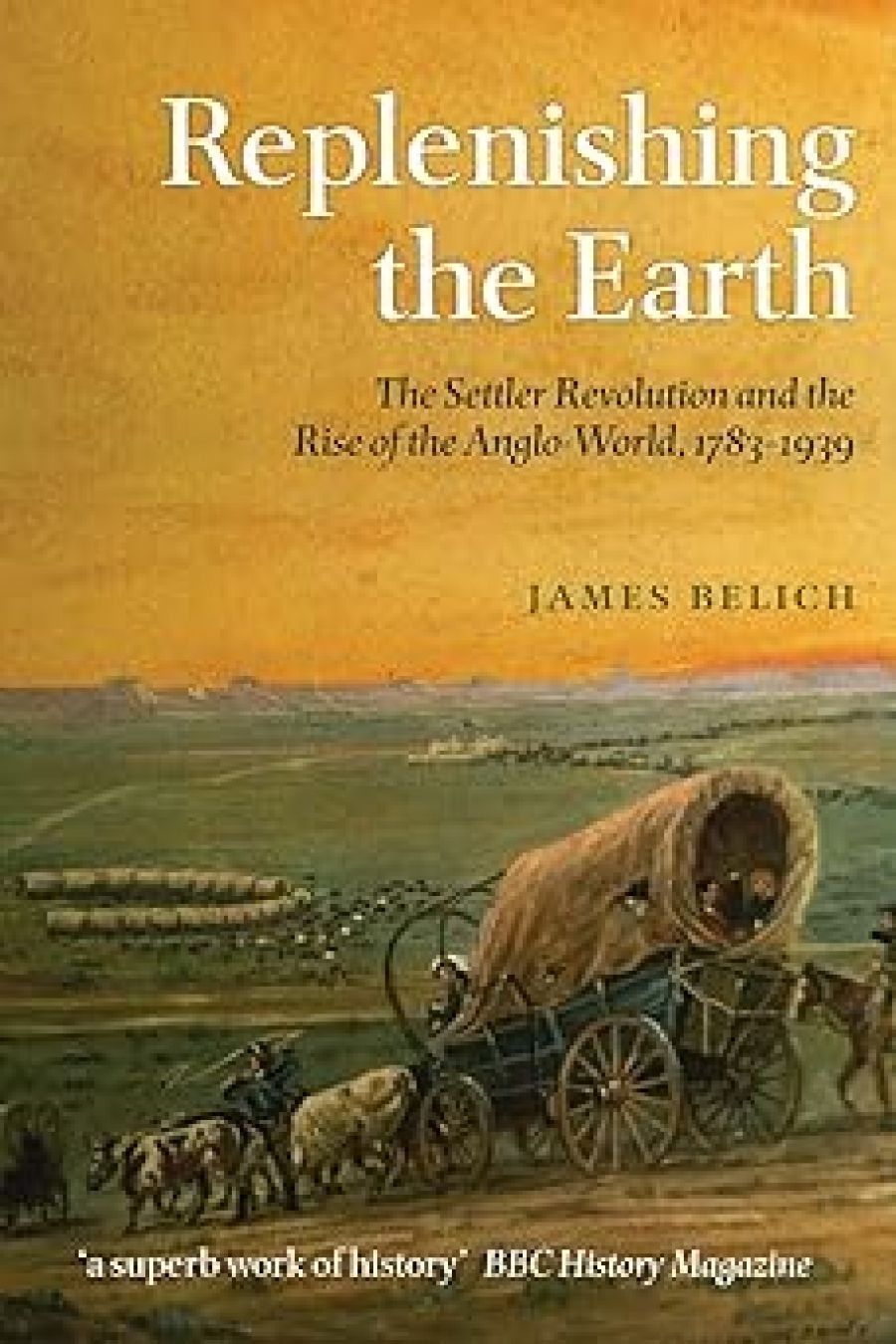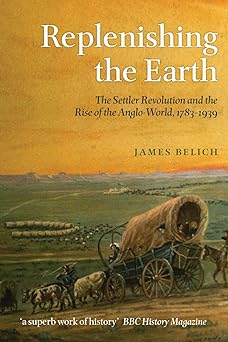
- Free Article: No
- Contents Category: History
- Review Article: Yes
- Article Title: Great swarm of bees
- Article Subtitle: A major new history of the Settler Revolution
- Online Only: No
- Custom Highlight Text:
It is always a pleasure to sit down with a fat book by New Zealand historian James Belich. He writes with verve and takes a big-picture view of the past, giving you plenty to think about and, better still, much to argue with. Until lately he has been mainly known for his fine-grained histories of New Zealand and its Maori Wars. Now he ascends to the stratosphere for an Olympian survey of white folks pouring in astonishing numbers into the newly accessible regions of Australasia, Africa, Siberia and the Americas during the nineteenth century. From this exalted perspective they look like nothing so much as a great swarm of bees diverging into several different streams in search of new hives. There had been nothing like this concentrated great voluntary migration in the history of mankind.
- Book 1 Title: Replenishing The Earth
- Book 1 Subtitle: The Settler Revolution And The Rise Of The Anglo-World, 1783–1939
- Book 1 Biblio: Oxford University Press, $59.95 hb, 573 pp
- Book 1 Cover Small (400 x 600):

In line with current trends in historical research, Belich demonstrates the delights and insights to be gained by taking a transnational, global perspective, an approach he calls Hypercolonial. (Belich likes to invent his own terminology and is partial to Teutonic Uppercase Letters.) From this vantage point, the similarities in the development of the new settlement colonies loom much larger than the differences. There was not one West, but many. This provides a welcome corrective to the doc-trines of American exceptionalism so influential in recent decades.
Belich wants this Settler Revolution acknowledged on a par with the American, the French and the Industrial Revolutions. More than that, he wants to convince us that the Settler Revolution at least accelerated and probably caused the Industrial Revolution to happen first in Britain. Most of the fun in his book arises from his effort to turn conventional accounts of migration and settlement on their heads.
Investment experts say the best way to make money in a gold rush is not to prospect but to sell shovels to prospectors. Belich pushes the old adage further, arguing in effect that shovel sellers cause gold rushes. Here’s how he thinks the process worked. Technological advances in transportation at the turn of the nineteenth century made it possible to carry immigrants in unprecedented numbers to sparsely populated, faraway places. This Mass Transfer unleashed Explosive Colonisation. Intoxicated by the prospects of instant wealth, the settlers raised cities on virgin soil, planted churches, founded newspapers, joined clubs, hired teachers, built opera houses and installed the whole apparatus of modern urban society. They did these things not because they were duped by unscrupulous promoters, but because they truly believed their own hype. In Belich’s words, they were acolytes of the new ideology of Settlerism.
All this feverish activity generated jobs galore. Barns had to be raised, houses built, roads made, canals dug, water reservoirs constructed and sewage flushed away. In contrast to traditional economic historians, who emphasise the exports flowing from newly founded settlements, Belich counts the imports. Finding that their value hugely exceeded exports in the early years, he credits settlement itself with creating economic booms. As shovels pour in, shovel sellers get rich. So do bankers, contractors, surveyors and developers.
Of course, this is all too good to be true. It ends in tears when a bust ends the boom. Unsold shovels rust in overstocked warehouses. At that point, the desperate settlers look for something to save them from ruin. They find their salvation in exporting gold, cotton, timber, wool, tinned fish, refrigerated meat – anything that can be marketed in the old country from which they came. This Belich calls Export Rescue. Crafting the quality of their exports to the tastes of distant Londoners or New Yorkers, they at length find reliable outlets for their produce. To generate the funds they need for further development, they turn to metropolitan banks and investors. While this proves a lifesaver in the short term, they find themselves dependent on the men in black hats. Instead of achieving independence they are Recolonised. Belich credits the phenomenon of Recolonisation with a raft of surprising, counter-intuitive effects, especially the growth of pro-Empire feeling in Australia, New Zealand and Canada in the first half of the twentieth century. He also thinks it helped the North win the American Civil War by arousing Union patriotism among settlers of the northern Midwestern states.
Belich has a terrific eye for detail, which makes his book a marvellous compendium of little-known facts. His statistics on the comparative growth of Melbourne, Chicago and Los Angeles are both entertaining and enlightening. However, there is something vaguely unsettling about his main thesis that settlement booms caused commodity exports rather than the other way around. Surely the expectation that staple commodities would power economic growth led settlers to risk everything on the great adventure of migration. They undoubtedly overestimated the speed with which the foundations for commodity exports could be laid. But that is the way of all speculation. Adventurous investors gamble that a big pay-off will come their way if they get in early on a gold rush, a new technology, product or advance in communication. Most of them will be wrong – as, for example, Telstra and Optus were wrong in the mid-1990s when they engaged in an insane roll-out of duplicate lines of fibre optic cable along the same suburban Australian streets.
Comparable scenes were played out on the North American prairies in the nineteenth century as railroads competed for transcontinental trade in commodities that had yet to be mined, planted, pastured or felled. It was not that building broadband networks and railways was folly, just that building too much in advance of commodity production risked ruin for the promoters. A prime example was the construction of my birthplace, Port Townsend, Washington, in the Pacific Northwest, where the expectation of becoming a railway terminus led to the construction of grand hotels, banks, emporia and mansions that fell into stately disrepair when the railroad failed to arrive – and only got spruced up decades later when tourists flocked to see them.
Belich appears to argue that the Settler Revolution proceeded without reference to the real prospects for profits to be reaped from commodity exports. Closer examination will show the settlers’ great expectations in every region were based on rational appraisals of productive possibilities. While settlement demonstrably burgeoned ahead of wool production in Tasmania and the South Island of New Zealand, the settlers who went there were fully aware of the super profits accruing to the squatters who had first sent their sheep running on the distant pastures of New South Wales. The Georgian mansions raised at the height of the wool boom in Tasmania, and the personal fortune built in a few short years by the novelist Samuel Butler (The Way of All Flesh) in the province of Canterbury in New Zealand, testify to the reasonableness of their ventures. Where expectations were unreasonable, colonists waited in vain for Export Rescue.
Western Australia had an early settler boom called ‘Swan River Mania’. When it collapsed in the early 1830s, colonists exercised their minds in search of something to export, but nothing much worth exporting would grow in their vicinity. In the 1840s they tried Import Rescue, by successfully imploring the British government to send them some convicts. But nothing sufficed to raise their capital, Perth, into anything larger than a village until gold in payable quantities was discovered at Coolgardie in the 1890s. Only then did the West throw off its reputation as the ‘Cinderella colony’.
The Settler Revolution itself had precedents in Britain, which help to explain why there were so many ready to risk lives and fortunes in migration. As factories, mills and mines developed in eighteenth-century England, tiny Midland villages suddenly grew into big cities – authentic settler boomtowns named Birmingham, Manchester, Sheffield and Leeds. Speculators readily grasped the possible profits to be made by speeding up transportation between the new centres of production and distribution by replacing the hopeless old road system with modern canals. The result was what contemporaries called ‘Canal Mania’. The bubble eventually burst in the great crash of 1793, and thousands lost their shirts. Undoubtedly, enthusiasm for the new cities, factories and canals had caused expectations to outrun development, just as they would in new settlement colonies overseas. But the achievements of the Midland Settler Revolution were real, and lived on to inspire imitators in distant lands.
Belich wonders, as others have before him, why English-speaking people should have figured so prominently in the Settler Revolution. Even after making allowance for some prodigious achievements in settlement by Russian, Chinese and Spanish-speaking people, he thinks some special inclination toward ‘Settlerism’ as an ideology existed among the British. The example of Midlands development and canal mania helps explain how this came to be. It is also worth considering that Britain was among the first regions of Europe, where the country-side gave up much of its agricultural labouring population, partly due to forced removals, partly to voluntary migration to cities. In many other parts of Europe, peasants remained tied to the land and, as a result, contributed little to out-migration until the late nineteenth century.
Another factor, surely, was that Britain so comprehensively ruled the waves after Nelson destroyed French sea power at Trafalgar. Without the protection provided by the British navy, colonisation beyond the seas was unlikely to attract venture capital and migrants. Otherwise, settlement was possible only as an expansion of existing land frontiers: as was the case in the American West, Turkey, Russia, South Africa and China.
Even a book that runs to six hundred pages can’t do everything, but it is too bad that Belich spends so little time on the politics of Settlerism, especially demands to exercise absolute authority over indigenous people. The willingness of successive Liberal governments to accede to unjust settler demands poses a puzzle yet to be solved. Perhaps this supremely accomplished historian will turn his hand to that problem in some future blockbuster.


Comments powered by CComment